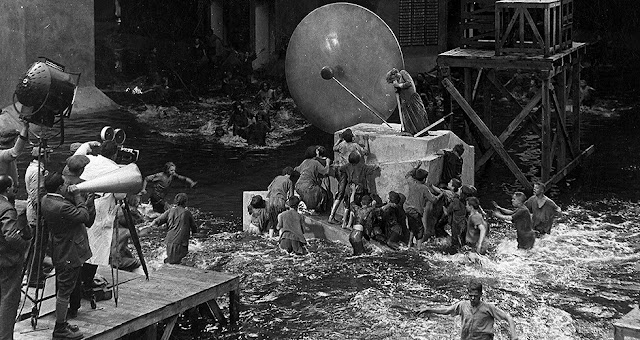Whereas set pieces such as the
Ark, hospital, dam and Diego were in my mind from early on in the writing of The Madagaskar Plan, the NACHTSTADT sequence
came late in the process.
 |
| The inspiration for Nachtstadt... |
[Spoiler alert.] It went
through multiple incarnations – the only consistent thread being it was the
store where Salois gets replacement explosives. At one point it was on an
island in the middle of a lake (a real place I passed on the road to Mandritsara);
in another it was an oil-rig like structure protected by Walküre gunships. The
actual action changed as well, including at one point Globus being present and
taking Madeleine hostage. None of these worked – they struck me as overly
dramatic, more akin to the train/helicopter chase in the first book and I was
consciously trying to move away from such ‘excessive’ set pieces. For months I
was unable to find an alternative.
As always when I’m stuck I
turn back to Homer and began thinking of the scene set on Circe’s island – where
Odysseus’s crew are turned to pigs by magic. Then when flicking through the
hundreds of photographs I took in Madagascar I came across this one:
Through that odd, alchemic
process that is creation – and tying into the modus operandi of the second rebellion
– the location for the scene became a gigantic pig farm. So far all the places
I’ve described in Madagascar were based on real locations. Nachtstadt was
entirely made-up, though with a nod to reality: Himmler did have several farms
where he experimented with livestock techniques.
In keeping with the Homeric
reference, I initially wanted to name the place after Circe’s island but that
is called Aeaea which I thought was too difficult to pronounce; the Roman
equivalent, Ponza, sounded too comic (and Japanese) to me. So I turned to James
Joyce. The Circe equivalent in Ulysses
is set in Nighttown, the red light district of Dublin... which translated into
German is, of course, Nachtstadt.
N is also for Nightingale
I often take a long time to
come up with the right name for a character. In the meantime, while plotting or
writing, I need some signifier (I hate using just A, B, C etc). In Fatherland there is an American diplomat
called Henry NIGHTINGALE. So when I came to write the scenes with America’s
envoy to Madagaskar, and before I had a name for him, I temporarily used
Nightingale.
I never found an alternative
and as time went on the name just stuck. So I confess indolence on my behalf
rather than some clever reference! In the early drafts Nightingale had a much
larger role in the book – but it got trimmed back. [Spoiler alert.] If you want
to know how he originally fitted into the plot I suggest you compare the
description of him in Chapter 34 with that of the unnamed fourth man at the
table with Rolland, Salois et al in Chapter 13. I based my description on the
assistant director and occasional actor Jerry Ziesmer.
 |
| Jerry Ziesmer |



